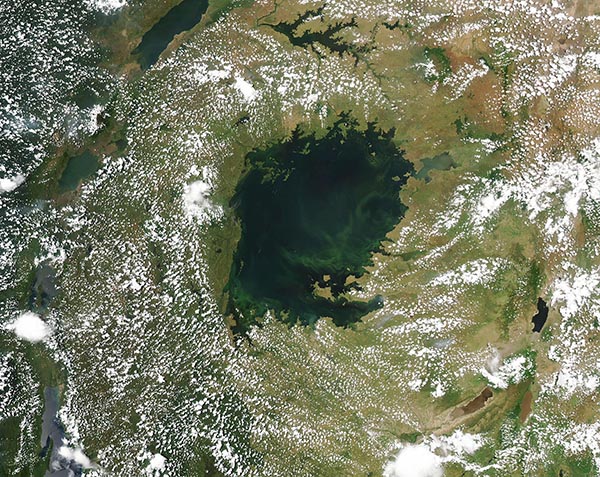Images
March 31, 2024 - Lake Victoria
Tweet
On March 18, 2024, the Moderate Resolution Imaging Spectroradiometer (MODIS) on NASA’s Aqua satellite acquired a true-color image of Lake Victoria surrounded by popcorn cloud.
Lake Victoria, sometimes called the “freshwater heart of Africa”, covers an area roughly the size of Scotland. It is the biggest lake in Africa and the second freshwater lake in the world. Straddling parts of Uganda, Kenya, and Tanzania, the lake is a vital resource to the region. It provides an economically important fishery, hydroelectric power, drinking water, and water for agriculture for millions of people in the Victoria Basin. The lake is also extremely biodiverse, with hundreds of endemic species (those found nowhere else), including a wide array of stunning, colorful, and niche-dwelling cichlids that have become famous as sought-after aquarium fish.
The health of Lake Victoria faces several challenges, including a voracious and large population of non-native fish known as the Nile Perch. Since their introduction in the 1940s, they have preyed on the small cichlids and exterminated several species. Another major challenge is the frequent occurrence of harmful algae blooms (HAB). These produce toxins that can harm people, aquatic life, and even livestock. Warming surface temperatures of the lake, runoff of fertilizer from nearby agriculture, and the decimation of algae-eating species of cichlids all encourage growth of phytoplankton (microscopic plant-like organisms), including both non-harmful and HABs. The streaks of green color seen in this image mark a widespread bloom of phytoplankton.
Image Facts
Satellite:
Aqua
Date Acquired: 3/18/2024
Resolutions:
1km (930.1 KB), 500m (930.1 KB), 250m (2.2 MB)
Bands Used: 1,4,3
Image Credit:
MODIS Land Rapid Response Team, NASA GSFC
Tweet
On March 18, 2024, the Moderate Resolution Imaging Spectroradiometer (MODIS) on NASA’s Aqua satellite acquired a true-color image of Lake Victoria surrounded by popcorn cloud.
Lake Victoria, sometimes called the “freshwater heart of Africa”, covers an area roughly the size of Scotland. It is the biggest lake in Africa and the second freshwater lake in the world. Straddling parts of Uganda, Kenya, and Tanzania, the lake is a vital resource to the region. It provides an economically important fishery, hydroelectric power, drinking water, and water for agriculture for millions of people in the Victoria Basin. The lake is also extremely biodiverse, with hundreds of endemic species (those found nowhere else), including a wide array of stunning, colorful, and niche-dwelling cichlids that have become famous as sought-after aquarium fish.
The health of Lake Victoria faces several challenges, including a voracious and large population of non-native fish known as the Nile Perch. Since their introduction in the 1940s, they have preyed on the small cichlids and exterminated several species. Another major challenge is the frequent occurrence of harmful algae blooms (HAB). These produce toxins that can harm people, aquatic life, and even livestock. Warming surface temperatures of the lake, runoff of fertilizer from nearby agriculture, and the decimation of algae-eating species of cichlids all encourage growth of phytoplankton (microscopic plant-like organisms), including both non-harmful and HABs. The streaks of green color seen in this image mark a widespread bloom of phytoplankton.
Image Facts
Satellite:
Aqua
Date Acquired: 3/18/2024
Resolutions:
1km (930.1 KB), 500m (930.1 KB), 250m (2.2 MB)
Bands Used: 1,4,3
Image Credit:
MODIS Land Rapid Response Team, NASA GSFC




